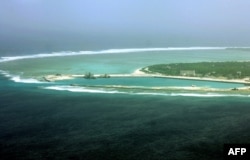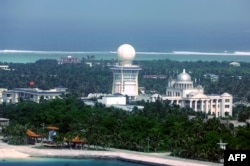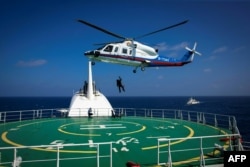A planned expansion of the biggest city in the once all but uninhabitable South China Sea will strengthen China's control over the waterway, despite rival claims by five governments.
The city of Sansha, anchored by a tiny tropical islet south of the Chinese mainland, will "obtain new breakthroughs" in infrastructure, environmental protection, people's livelihoods and integration of the military, municipal Communist Party Secretary Zhang Jun said March 22 on the city's website.
A population today of about 1,500 makes Sansha the largest city in the South China Sea and helps China control the whole Paracel archipelago. Taiwan and Vietnam also claim the Paracels. The Chinese government spars over sovereignty in parts of the South China Sea's Spratly Islands with Taiwan, Vietnam, Brunei, Malaysia and the Philippines.
Expansion of Sansha would bolster China's military and research advantages in the disputed 3.5 million-square-kilometer sea, in turn making its sovereignty claim more convincing, said Oh Ei Sun, senior fellow at the Singapore Institute of International Affairs.
"To strengthen your case under international law that you exercise sovereignty over a stretch of land or sea, you would have to show that you have administration, you would have to show that you have people actually living there and then they are making a livelihood, for example," Oh said.
Growing city
Last year was a "milestone" period for Sansha's expansion, the party secretary said on the city website. He did not announce specific plans for 2019.
Today the city centered on Woody Island covers 10 square kilometers, enough for a hospital, a bank branch and stores. The most developed of any settlement in the sea, Sansha has the "role as both a military and civilian basing and logistics hub," said Gregory Poling, director of the Asia Maritime Transparency Initiative under the Washington-based research organization Center for Strategic and International Studies.
A bigger city will let China expand ocean research at nearby islands, reinforce military installations and develop tourism, analysts believe.
A cruise ship named the Princess Coconut is planned to make two-day journeys, the booking service Chinatravelguide.com says.
Woody Island is already pivotal to Chinese military power in the resource-rich sea, CSIS says. The island now supports an air base, early-warning radar facilities and a surface-to-air missile system, the initiative says. The other claimant countries lack China's military strength.
Bolstering claims
Chinese officials cite historic documents to back their claim of about 90 percent of the sea, which stretches from Hong Kong to the island of Borneo. China and the other five governments that claim sovereignty value the sea for its fisheries, shipping lanes and energy reserves under the seabed.
Growth of the city will give China a "track record" of administration over the islands, said Stephen Nagy, senior associate politics and international studies professor at International Christian University in Tokyo.
The Permanent Court of International Justice considers a continual display of authority as an "effective administrative exercise" in the South China Sea, according to a Cambridge International Law Journal analysis in 2015.
"What we're seeing is China trying to build a case that fits in within the context of international law and erodes the claims of other claimants in the region," Nagy said. "It has the unique capacity based on its ability to build infrastructure in ways that Vietnam and [the] Philippines and other countries in the region can't do."
China lost a world arbitration court ruling to the Philippines over the disputed sea in 2016 because the court disagreed with the legal basis for its maritime claims.
Malaysia, Taiwan, Vietnam and the Philippines send civilians to the Spratly chain. Other countries' civilian activity lacks the scale of China's, Shinji Yamaguchi, senior research fellow at the Tokyo-based National Institute for Defense Studies, wrote in a 2017 research paper.
"Although China is not alone in using non-military measures to enhance its claims, its efforts are greater than its neighbors' in both scale and impact," Yamaguchi wrote.
Offshore reactions
Other countries will probably say little, though Vietnam might "make noise," the Singapore Institute's Oh said.
Vietnam might just repeat verbal assertions of its claims to the South China Sea, said Trung Nguyen, international relations dean at Ho Chi Minh University of Social Sciences and Humanities. If it feels increasingly pushed out, he said, the government might turn to foreign powers including Western European countries for help, he said.
"They are waiting for goodwill behavior from China," Nguyen said. "I think that if China keeps pushing forward with their territorial expansions in the South China Sea, Vietnamese leaders, especially those who are China-friendly, will realize they've got to find another way to counter against China."
Since the 2016 arbitration court ruling, China has kept peaceful ties with most other maritime claimants by offering them economic support.











